 | | | Switch to: Europe, USA, New Zealand, Antarctica Credit: NOAA/Ovation  Planetary K-index Planetary K-index
Now: Kp= 6 storm
24-hr max: Kp= 6 storm
explanation | more data
Interplanetary Mag. Field
Btotal: 16.48 nT
Bz: 16.25 nT north
more data: ACE, DSCOVR
Updated: Today at 1146 UT  Coronal Holes: 17 Aug 22 Coronal Holes: 17 Aug 22 
Solar wind flowing from this long equatorial coronal hole should reach Earth on August 18-19. Credit: SDO/AIA  Noctilucent Clouds Noctilucent Clouds
Noctilucent cloud season is underway--but also nearing its end. AIM images show the polar ring of NLCs is contracting as northern summer winds down. Switch view: Europe, USA, Asia, Polar Updated Aug17  SPACE WEATHER
NOAA Forecasts | | Updated at: 2022 Aug 17 2200 UTC FLARE | 0-24 hr | 24-48 hr | CLASS M | 40 % | 40 % | CLASS X | 10 % | 10 % |  Geomagnetic Storms: Geomagnetic Storms:
Probabilities for significant disturbances in Earth's magnetic field are given for three activity levels: active, minor storm, severe storm Updated at: 2022 Aug 17 2200 UTC Mid-latitudes | 0-24 hr | 24-48 hr | ACTIVE | 15 % | 25 % | MINOR | 35 % | 35 % | SEVERE | 50 % | 25 % | High latitudes | 0-24 hr | 24-48 hr | ACTIVE | 01 % | 05 % | MINOR | 05 % | 15 % | SEVERE | 90 % | 75 % | | | |  | | | | | | | | | | | Never miss another geomagnetic storm. Sign up for Space Weather Alerts and you'll receive a text message when magnetic storms erupt. Aurora your guides and professional astronomers use this service. You can, too! | | | CME SPARKS GEOMAGNETIC STORM: A CME hit Earth's magnetic field on Aug. 17th (0316 UT). First contact had little effect, but hours later while Earth was passing through the CME's wake, a G2-class geomagnetic storm broke out. It's over now, but more storms could be in the offing. A series of CMEs is expected to graze Earth's magnetic field on Aug. 18-19, potentially sparking a strong G3-class geomagnetic storm. Geomagnetic storm alerts: SMS Text SUNSPOT AR3078 KEEPS EXPLODING: For the 3rd day in a row, active sunspot AR3078 is producing strong M-class solar flares. The latest, an M2-category explosion on Aug. 17th (1345 UT), hurled a plume of cool dark plasma into space: 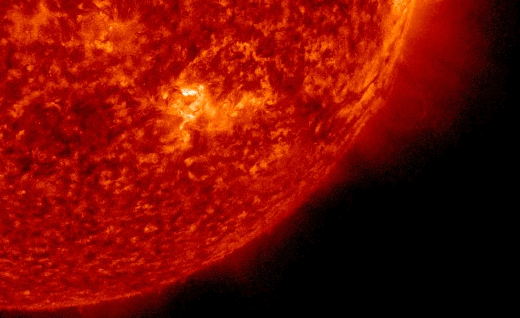
A CME will almost certainly emerge from the blast site (confirmation awaits fresh data from SOHO). But will it hit Earth? Like other CMEs AR3078 has produced this week, this one will skate the southern edge of the Earth strike zone. If it does hit us, the blow will be grazing, not full strength. However, even a grazing blow can cause a geomagnetic storm, especially in combination with other impacts, so stay tuned. Solar flare alerts: SMS Text Realtime Aurora Photo Gallery
Free: Spaceweather.com Newsletter COSMIC RAY YIN-YANG PENDANT: To celebrate the yin-yang relationship between solar activity and galactic cosmic rays, the students of Earth to Sky Calculus just launched a yin-yang pendant to the stratosphere. On July 23rd, it flew 104,265 ft high onboard a cosmic ray research balloon: 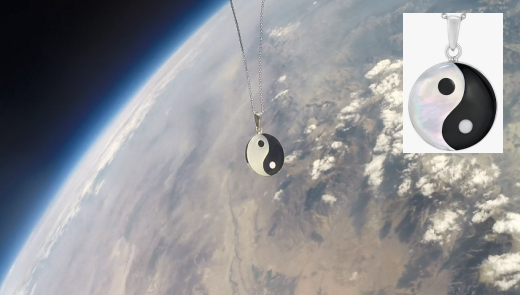
You can have it for $133.95. In this pendant, a sterling silver frame surrounds balancing swirls of black onyx and mother of pearl--all suspended from a matching 18-inch sterling silver chain. It makes a great anniversary, birthday or (never too early!) Christmas gift. The students are selling yin-yang pendants to support their cosmic ray ballooning program. Each one comes with a greeting card showing the pendant in flight and telling the story of its journey to the edge of space and back again. Far Out Gifts: Earth to Sky Store
All sales support hands-on STEM education A COMET WITH TWO TAILS: Something special is happening to Comet C/2017 K2 (PanSTARRS). It's about to plunge through Earth's orbital plane (a.k.a. the ecliptic). The passage is giving us a rare view of the comet's two tails: 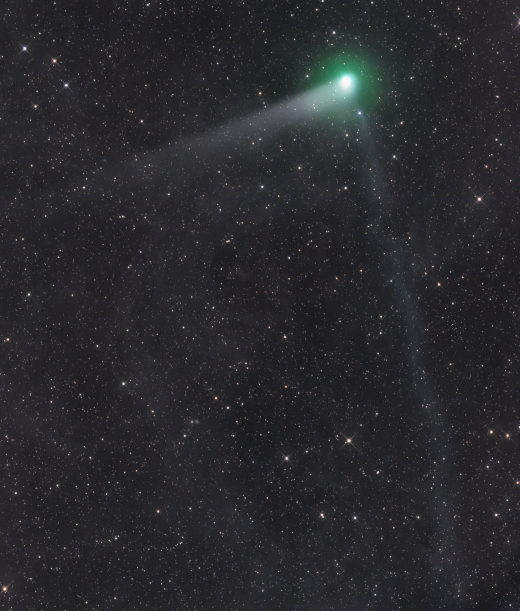
Gerald Rhemann took the picture on Aug. 15th using a 12-inch telescope in Farm Tivoli, Namibia. It shows Comet K2's dust tail pointing left, and its gaseous ion tail pointing down almost 90 degrees away. All comets have two tails. Think about the material vaporizing from a comet's nucleus. It's a mixture of gas and dust. Lightweight gas is blown straight away from the sun by solar wind. Heavier dust lags behind, more closely tracing the comet's orbit. Voilà--two tails. Playing with Comet K2's interactive 3D orbit reveals why the two tails are currently at right angles. This beautiful geometry will persist for some time. The exact date that Comet K2 passes through the ecliptic plane is Aug. 25th, but it will remain close to the plane for weeks. Astrophotographers, point your optics here. Realtime Space Weather Photo Gallery
Free: Spaceweather.com Newsletter
Realtime Noctilucent Cloud Photo Gallery
Free: Spaceweather.com Newsletter
Every night, a network of NASA all-sky cameras scans the skies above the United States for meteoritic fireballs. Automated software maintained by NASA's Meteoroid Environment Office calculates their orbits, velocity, penetration depth in Earth's atmosphere and many other characteristics. Daily results are presented here on Spaceweather.com. On Aug 17, 2022, the network reported 30 fireballs.
(22 sporadics, 6 Perseids, 1 southern delta Aquariid) 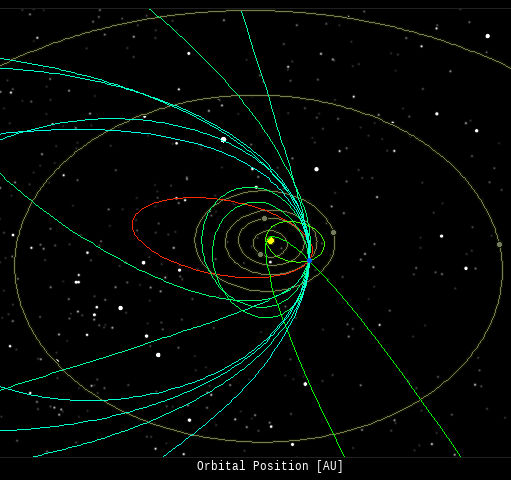 In this diagram of the inner solar system, all of the fireball orbits intersect at a single point--Earth. The orbits are color-coded by velocity, from slow (red) to fast (blue). [Larger image] [movies] Potentially Hazardous Asteroids ( PHAs) are space rocks larger than approximately 100m that can come closer to Earth than 0.05 AU. None of the known PHAs is on a collision course with our planet, although astronomers are finding new ones all the time. On August 17, 2022 there were 2288 potentially hazardous asteroids.
 | Recent & Upcoming Earth-asteroid encounters: | Asteroid | Date(UT) | Miss Distance | Velocity (km/s) | Diameter (m) | | 2015 FF | 2022-Aug-12 | 11.2 LD | 9.2 | 17 | | 2022 PX1 | 2022-Aug-12 | 2.8 LD | 35.1 | 125 | | 2022 OT1 | 2022-Aug-13 | 12.4 LD | 5.8 | 36 | | 2022 OA4 | 2022-Aug-14 | 18.2 LD | 7.9 | 23 | | 2022 PJ1 | 2022-Aug-16 | 11 LD | 5.9 | 19 | | 2022 PW | 2022-Aug-16 | 1.4 LD | 7.5 | 30 | | 2022 QA | 2022-Aug-16 | 0.8 LD | 15.2 | 14 | | 2022 PC | 2022-Aug-18 | 16.5 LD | 4.1 | 60 | | 2019 AV13 | 2022-Aug-20 | 13.8 LD | 9.2 | 135 | | 2020 QW3 | 2022-Aug-22 | 14.1 LD | 18.1 | 30 | | 2015 QH3 | 2022-Aug-22 | 5.6 LD | 7 | 14 | | 2017 BU | 2022-Aug-29 | 15.8 LD | 7 | 32 | | 2021 CQ5 | 2022-Sep-01 | 8.7 LD | 13.5 | 7 | | 2008 RW | 2022-Sep-12 | 17.5 LD | 10.2 | 98 | | 2020 PT4 | 2022-Sep-15 | 19.7 LD | 10.8 | 39 | | 2016 HF2 | 2022-Sep-29 | 19.2 LD | 5.6 | 21 | | 2018 ER1 | 2022-Oct-02 | 14.7 LD | 4 | 27 | | 2018 VG | 2022-Oct-05 | 18.5 LD | 6.7 | 12 | | 2021 TJ10 | 2022-Oct-06 | 19.6 LD | 8.1 | 6 | | 2006 SG7 | 2022-Oct-07 | 16.7 LD | 18.4 | 93 | | 2013 TJ6 | 2022-Oct-07 | 11.7 LD | 14.4 | 32 | | 2013 SL20 | 2022-Oct-14 | 6.2 LD | 12.1 | 45 | | 2020 TO2 | 2022-Oct-15 | 1.4 LD | 12.6 | 18 | Notes: LD means "Lunar Distance." 1 LD = 384,401 km, the distance between Earth and the Moon. 1 LD also equals 0.00256 AU. | | Cosmic Rays in the Atmosphere | SPACE WEATHER BALLOON DATA: Almost once a week, Spaceweather.com and the students of Earth to Sky Calculus fly space weather balloons to the stratosphere over California. These balloons are equipped with sensors that detect secondary cosmic rays, a form of radiation from space that can penetrate all the way down to Earth's surface. Our monitoring program has been underway without interruption for 7 years, resulting in a unique dataset of in situ atmospheric measurements. Latest results (July 2022): Atmospheric radiation is decreasing in 2022. Our latest measurements in July 2022 registered a 6-year low: 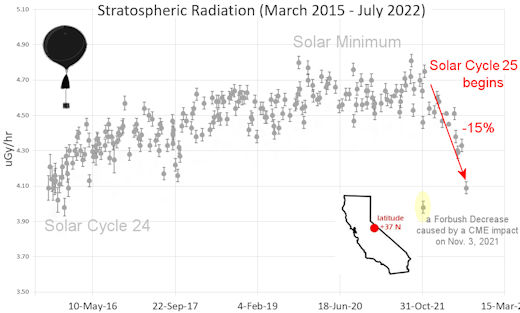
What's going on? Ironically, the radiation drop is caused by increasing solar activity. Solar Cycle 25 has roared to life faster than forecasters expected. The sun's strengthening and increasingly tangled magnetic field repels cosmic rays from deep space. In addition, solar coronal mass ejections (CMEs) sweep aside cosmic rays, causing sharp reductions called "Forbush Decreases." The two effects blend together to bring daily radiation levels down. .Who cares? Cosmic rays are a surprisingly "down to Earth" form of space weather. They can alter the chemistry of the atmosphere, trigger lightning, and penetrate commercial airplanes. According to a study from the Harvard T.H. Chan school of public health, crews of aircraft have higher rates of cancer than the general population. The researchers listed cosmic rays, irregular sleep habits, and chemical contaminants as leading risk factors. A number of controversial studies (#1, #2, #3, #4) go even further, linking cosmic rays with cardiac arrhythmias and sudden cardiac death. Technical notes: The radiation sensors onboard our helium balloons detect X-rays and gamma-rays in the energy range 10 keV to 20 MeV. These energies span the range of medical X-ray machines and airport security scanners. Data points in the graph labeled "Stratospheric Radiation" correspond to the peak of the Regener-Pfotzer maximum, which lies about 67,000 feet above central California. When cosmic rays crash into Earth's atmosphere, they produce a spray of secondary particles that is most intense at the entrance to the stratosphere. Physicists Eric Regener and Georg Pfotzer discovered the maximum using balloons in the 1930s and it is what we are measuring today. | | The official U.S. government space weather bureau | | | The first place to look for information about sundogs, pillars, rainbows and related phenomena. | | | Researchers call it a "Hubble for the sun." SDO is the most advanced solar observatory ever. | | | 3D views of the sun from NASA's Solar and Terrestrial Relations Observatory | | | Realtime and archival images of the Sun from SOHO. | | | information about sunspots based on the latest NOAA/USAF Active Region Summary | | | current counts of failed and deployed Starlink satellites from Jonathan's Space Page | | | Authoritative predictions of space junk and satellite re-entries | | | from the NOAA Space Environment Center | | | fun to read, but should be taken with a grain of salt! Forecasts looking ahead more than a few days are often wrong. | | | from the NOAA Space Environment Center | | | the underlying science of space weather |  | BestCSGOGambling is the best site for everything related to CSGO gambling on the web |  | To find reviews of new online casino sites in the UK try The Casino DB where there are hundreds of online casino reviews complete with bonuses and ratings. Alternatively, Online-Casinos.xyz is another massive directory of online casinos listing sites for the UK and Worldwide. Casinos that offer Rupees for bonuses are very generous to Indian players. Find the best online casinos in India at AllCasinos.in Looking for a new online casino? Try Casimpo the new site dedicated to making online casino simple, or check out the new Avenger Slots Casino and Ace Online Casino with over 500 online slots and casino games. |  | One of the most popular casino games is the Book Of Dead Slot based on ancient Egyptian text, you can find all the casinos with spins at bookofdeadslotsites.com. |  | When looking for casinos to play online when the weather is bad, you can try casino online trucchi for Italian games. If you are not from Finland you can try the Swedish page Svenska casino online to find suitable games, check out svenskacasinoonline.net. Always check your local laws before playing with real money. |  | Looking for sports betting companies not registered on GamStop? CasinoGap has presented a list of sites not on GamStop available for UK players. Check and bet online! Would you like to bet at sites not using GamStop? Look at a list of NonStopCasino sites for online betting that aren't on GamStop. Top-rated bookmakers ever! | | | These links help Spaceweather.com stay online. Thank you to our supporters! | | | | | | | | |  | |  |   | ©2021 Spaceweather.com. All rights reserved. This site is penned daily by Dr. Tony Phillips. | |

